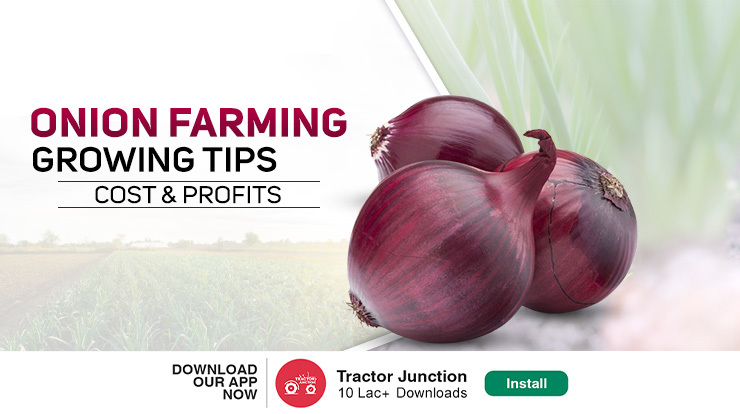
Onion is a traditional vegetable that is consumed worldwide. Globally, India is the second largest onion-growing country, which is famous for its pungency. Moreover, in India, onion crops are cultivated in two cycles.
The first crop cycle is ready to harvest from November to January. And, the second crop cycle is ready to harvest from January to May.
The onion is a hardy cool-season annual crop with narrow, hollow leaves, followed by a base pointing out from a bulb. Additionally, the onion bulb can be of either white, yellow, or red colour that often becomes ready to harvest within 80 to 150 days.
Maharashtra, Madhya Pradesh, Karnataka, and Gujarat are a few of the biggest onion-producing states in India. By applying best practices for farming, you can expect net earnings of up to Rs. 1.5 Lakh in India.
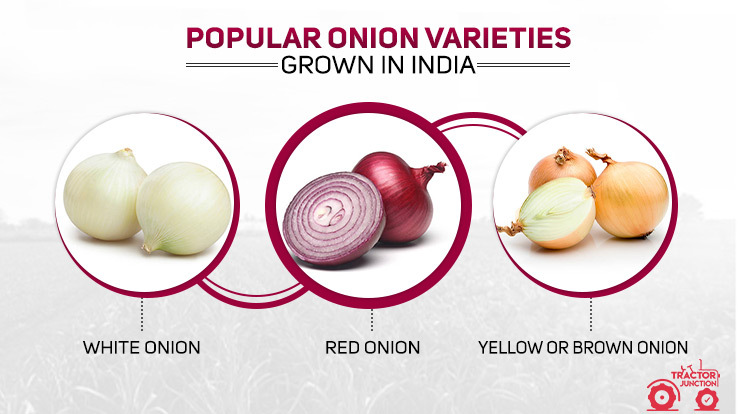
Let’s now dig deep into the onion farming tips to grow high-yielding varieties.
Do Check – Onion Planting & Harvesting Tips
How to Sow, Grow & Harvest Onions in India?
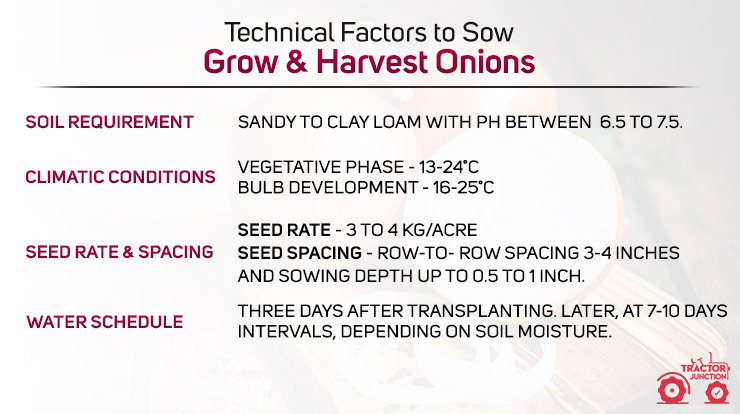
1. Soil requirements
Onion thrives well in sandy to clay loams with good water drainage capacity and pH ranging between 6.5 to 7.5. In addition, deep friable soils that are highly fertile and have great hummus are good options for cultivating onions.
Pro tip – Adding cow manure, organic waste, and compost in the process of onion farming will help add to the soil’s fertility.
2. Weather conditions
For the precise vegetative phase, a temperature between 13-24˚C is ideal. However, for the phase of bulb development, the temperature between 16-25˚C is highly suitable.
What if the temperature exceeds 35 degrees C?
If the temperature exceeds 35 degrees, the plants will start wilting. Moreover, they can even become infected with certain diseases.
There should be at least 70% relative humidity to sustain good growth of onion plants. And further on, the annual rainfall should be between 650-750 mm, with a good distribution of rainfall during the monsoon period.
3. Propagation of onions
Onions can be propagated from seeds. The seeds are transplanted to the field after 30-35 days of field preparation. Moreover, the ideal time to replant the plants is between 35 and 45 days.
Note – Plants of less than 30 days have a higher mortality rate, and plants above 45 days fail to grow to their fullest potential.
4. Land preparation
For onion cultivation, the land preparation is heavily reliant on the irrigation method you choose. Prepare the soil by ploughing the field until it reaches the finest tilth. Furthermore, add farmyard manure to the soil to lock nutrients and increase soil fertility.
Best Seasons for Onion Cultivation
Onion varieties are suitable to cultivate during kharif & Rabi seasons.
- For Kharif crops – It has a total crop period of 135 days, and transplantation happens between August and the first week of October.
- For Rabi crops – Nursery preparation typically starts in November and until December. Furthermore, the plants are transplanted in January or February.
5. Sowing & planting
You can start planting when the saplings are ready from the seed and are 35 days old. You must start planting at least 45 days before. Furthermore, if you keep deploying the planting process, expect the yield to be less. Moreover, gather only quality, well-treated, high-quality onion seeds for farming.
Did you check – How to grow White Onion for High Quality Yields?
6. Irrigation Requirement
As per traditional farming, flood irrigation is usually preferred to irrigate the onion fields. Hence, Irrigating the field weekly, once or twice, depending on the soil type and moisture, can be enough for organic onion farming in India.
However, farmers prefer drip irrigation to irrigate the field twice or at least once a week. Also, in case of high temperatures, the frequency of watering through drip irrigation can be done on an alternate-day basis.
7. Seed Rate & Spacing
You can sow around 75,000 to 120,000 plants on an acre of land but that too at a plant-to-plant distance of 10 to 15 cm. So, a single average size nursery can easily accommodate 4 kg of onion seeds in an acre of land.
8. Fertiliser & Nutrients for Onion Cultivation
Onion requires a great number of fertilizers to ensure optimal growth. Moreover, the quantity of onion farming fertilizer is highly dependent on the onion variety and the growing season.
Fertilizer for Kharif Variety
For this variety, you can expect a yield of 25-30 tonnes/hectare with:
- 75KG Nitrogen
- 40 KG potash
- 40 KG phosphorus
Fertilizer for Long Day Onion Crop
Onion variety with a yield of 100 tonnes per acre would require a fertilizer schedule as:
- 180 kg Nitrogen
- 60 kg phosphorus
- 70 kg Potassium
Note – Always identify the growing variety and the season to opt for the right fertilizer schedule.
9. Harvesting & Yield of Onion
You notice the leaves over the plant tearing apart in late summer or early fall. This process happens at the neck of the plant, signalling that the plant is ready to harvest.
When the plant appears young and green, they are bunched together for harvesting.
Yield from Onion Farming:
Onion farming yield can vary according to the varieties and temperature. Moreover, high-yielding onion varieties can help achieve a yield of up to 120 tonnes per acre. However, certain Kharif varieties can help achieve a yield of up to 20-30 tonnes per acre.
Find Which Onion Variety Gives Massive Yield
10. Post-Harvest Process for Onion Crops
Right after harvesting, you can stock the onions for up to 48 hours, provided the room temperature should be between 20-30 degrees, followed by 70% humidity. Additionally, upon doing this, you can expect to preserve onions for a good 6-8 months.
Cost & Earnings from Onion Farming – From an Acre
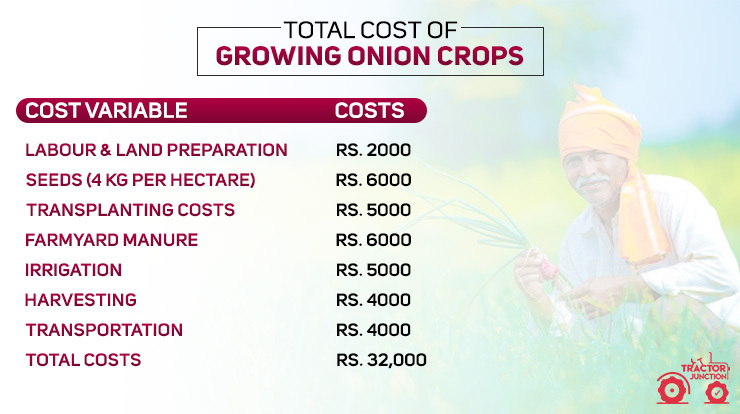
Note – These are average estimated costs for pursuing organic farming of onions. The actual costs can vary depending on your farming area and the scale at which you do it. So, expect the real costs to vary or be this similar.
- Expected Onion yield per acre = 70 Quintal Per Acre
- Total Earnings = 105000 (The market price of 15 Rs per kilo)
- Net profit = Total Earnings – Total Cost
73000 (Net profit) = 105000 (Total Earnings) – 32,000 (Total cost)
Hence, you can safely make Rs 73,000 from an acre of land if you leverage the right agri-resources and practices. Moreover, you can take your income or net earnings up to 1.5 Lakh if you plan to sow two crops yearly.
Top Producers of Onion in India
India has a 19% contribution to onion production worldwide, after China (which is at 27%).
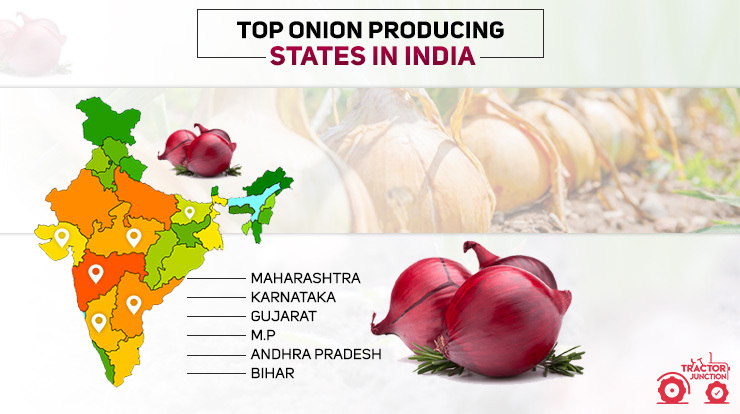
- Maharashtra leads the onion production with a 33% contribution to the overall country’s production.
- Karnataka is the second biggest producer, with a 17% stake in overall production.
- Following these two states, MP, Gujarat, Andhra, and Bihar are the other biggest producers of onions.
Final Thoughts on Onion Cultivation
With the above onion farming guide, you can grow high-yielding onion varieties and earn potentially good net earnings. Also, upon investing in the right agri-practices and employing the right farm mechanization solutions like the latest tractors, you can expect to earn up to Rs 73000.
Maharashtra & Karnataka are the leading producers of onion vegetables, as they have high crop areas and production volumes. Starting onion cultivation is easy, provided you add best practices and techniques.
Frequently Asked Questions on Onion Farming
Que. Which is the best soil for onion farming?
Ans. Deep, sandy to clay loams with good water drainage properties and pH ranging between 6.5 to 7.5 are suitable for onion cultivation.
Que. How much is onion farming profit per acre in India?
Ans. You can earn up to Rs. 73,000 in net profit from onion farming in India.
Que. Which is the best fertilizer for growing onions?
Ans. Onions require a high source of nitrogen-source of nitrogen fertilizer (ammonium sulfate or ammonium nitrate).
Que. How much N:P: K is suitable for cultivating onions?
Ans. NPK fertilisers are highly recommended at 40: 20: 40 Kg/acre ratios.
Que. Is hydroponic onion farming possible?
Ans. Yes, it is possible to grow onion crops hydroponically.
Related Post
Wheat Farming in India
Horticulture Farming in India
What is Precision Farming?
